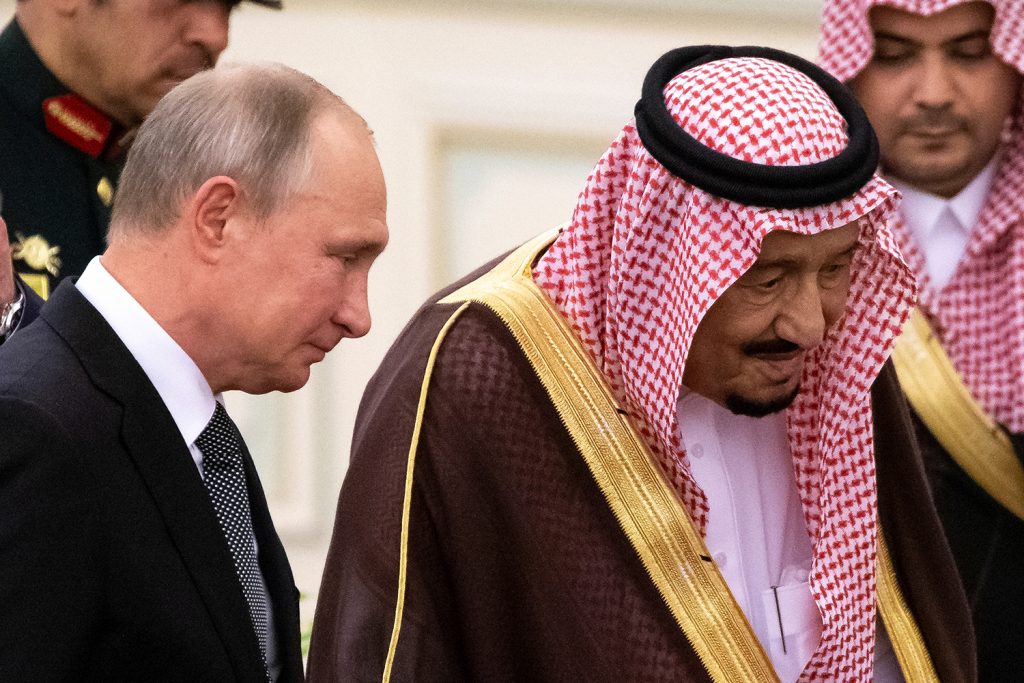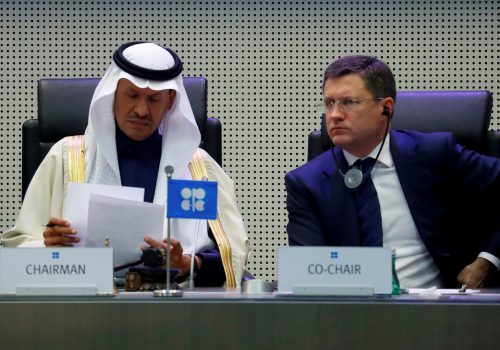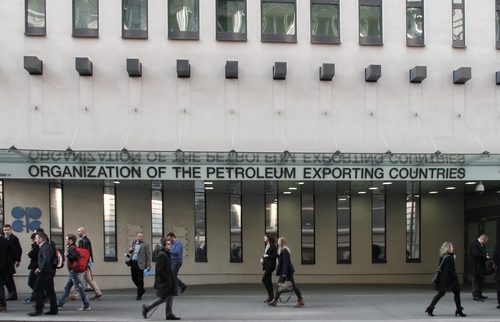The Saudi-Russian oil price war is not sustainable
When the Russian delegation walked out of their meeting with Organization of the Petroleum Exporting Countries (OPEC) Plus in Vienna on March 6, they clearly thought they had a plan. Despite the OPEC proposal for significant oil production cuts in the light of the demand destruction caused by the coronavirus, Moscow refused to take any additional production cuts and accepted that oil prices would fall as a result. As a consequence of the drop in oil prices, however, the US shale industry, which of the three countries’ markets has the highest cost base, would be undermined. Russia would then be able to obtain a greater share of the global oil market, as the US shale firms went bankrupt and exited that market. It would then be able to position itself as the leading global oil player.
Moscow did not expect the aggressive Saudi reaction, which has seen the Kingdom ramp up production to 13 million barrels per day (bpd), and oil prices fall toward $20 a barrel. The danger now for both Moscow and Riyadh is that they may trigger a long 1990s style oil price downturn, reinforced by low Chinese economic growth and an ongoing energy transition away from fossil fuels. Furthermore, the immediate collapse in demand caused by the coronavirus epidemic is likely to inflict substantial damage to businesses across the globe cratering demand for oil for several years. It is likely that this demand destruction will cause greater damage at least temporarily than the effects of the oil price war on price levels. As a consequence, both major oil producers need the United States and the European Union (EU) to take the radical financial steps necessary to support their own industries and provide support for business globally—thereby protecting global oil demand.
The impact of this price war combined with the demand destruction triggered by the impact of the coronavirus are likely to force both Russian and Saudi Arabia back to the negotiating table to agree a deal which will—at least in substance—restore OPEC plus, sooner rather than later.
The end of OPEC Plus?
The 2014 oil price collapse saw prices plummet from what had been a stable plateau of $110 a barrel in June 2014 to just $29 a barrel in January 2016. Several factors caused this collapse, including unexpectedly lower Chinese economic growth and the equally unexpected surge of shale oil production from the United States. The initial approach of OPEC led by Saudi Arabia was to increase production and then hope that shale oil, with its much higher production costs, would be forced to exit the market. However, it became increasingly clear that the US shale industry was much more flexible and capable than OPEC had anticipated. The shale industry reduced costs, introduced new technology, recapitalized under the procedures of US Federal bankruptcy law (known as Chapter 11) and as a consequence was able to sustain and then increase production.
These realities encouraged OPEC and Russia to meet in Vienna in the summer of 2016 and agree to cut production levels to push pricing levels toward $50 a barrel. This forum—which came to be known as OPEC plus—met every six months to agree production levels. The last agreement was made in the early winter of 2019 which would lapse in April 2020. The March meeting of OPEC plus in Vienna to set the next round of production agreements took place in the context of the demand destruction caused by the coronavirus. Saudi Arabia therefore proposed given the ongoing demand destruction a further round of production cuts amounting to 1.7 million bpd (including Russia itself accepting 300,000 bpd cuts). Much to the surprise of most observers, the Russian delegation refused further cuts and indicated they were prepared to let all the existing OPEC plus agreements lapse from April. Saudi Arabia responded aggressively by ramping up production by an initial additional 2 million bpd while offering selective high discounts to potential European customers. The consequence was a dramatic oil price collapse so that by April 1 the two key oil price indicators had fallen dramatically. Brent fell below $26 and West Texas Intermediate just above $20 a barrel. On March 5 before the Vienna OPEC plus meeting the oil price was almost $50 a barrel.
There are a number of underlying reasons for the Russian decision to refuse further production cuts and walk out of the OPEC plus arrangements.
First, a significant part of the Russian energy establishment never liked the concept of doing deals with OPEC. The larger Russian oil companies led by Rosneft wanted to be able to produce and sell without any limit or reference to OPEC. This is despite the fact that Russia rarely fully complied with its OPEC plus production obligations, only fully respecting production quotas during the Druzhba pipeline crisis in 2019.
A second reason was the impact of US shale. Igor Sechin, the CEO of Rosneft, in particular saw the OPEC plus deals as delivering extra revenues to neither Russia nor Saudi Arabia but to the US shale industry. To add insult to injury, US oil producers had also increased its sales to key target markets for Russian oil exports. For instance, at the end of 2019, under the phase one trade deal agreed with the United States, China agreed to buy significantly more oil from the United States. The United States had also offered to support trade deals with its energy companies and customers in Ukraine and Belarus. Furthermore, the rise of the United States as the world’s largest oil producer, has given the United States much room for maneuver to adopt energy-related sanctions against Russia, most notably in respect of Nord Stream 2 and in relation to Rosneft’s operations in respect of its support of the Venezuelan regime.
Moscow further believed that Saudi Arabia would have limited means of retaliation because it needs approximately $80 a barrel pricing in order to balance its budget. By contrast, Russia only requires half that price level to balance its budget. In addition, it has over the last few years built up a significant sovereign wealth fund, the National Welfare Fund (NWF), with over $150 billion in reserves, as well as foreign exchange reserves of over $500 million. It also believed that it was further insulated from the effects of an oil price decline by its willingness to let the Ruble fall with the oil price, cushioning production costs and the broader Russian economy against price drops.
The Russian plan appeared to be to let prices fall, draw on its fiscal and currency cushions while allowing lower prices to knock a large part of US production out of the market, and then seek to build market share.
A successful Russian plan?
It appears that Moscow miscalculated the Saudi reaction. Almost immediately after the collapse of OPEC plus negotiations, Riyadh announced an initial increase of production by 2 million bpd, followed by a further 1 million bpd. In addition, from April 1 Saudi Aramco offered potential European customers heavy discounts on current prices. This reaction sparked heavy falls in prices on the Brent and WTI global oil indices.
At first sight it looks as if Riyadh cannot, as Moscow surmised, sustain such level of production and low prices because of its need for much higher oil prices in order to balance its budget. However, on closer examination, Saudi Arabia appears to be in better shape than Russia to withstand significant and long running oil price falls. Whilst it is true that to balance the Saudi budget oil prices need to be around $80 a barrel is required, Saudi Arabia has both deeper resources and fewer demands on those resources. Saudi total nominal gross domestic product (GDP) is only $640 billion, with a population of 34 million. It has a sovereign wealth fund, the Public Investment Fund, of $320 billion, amounting to over 40 percent of GDP. By contrast Russia has a nominal GDP of $1.6 trillion, and its NWF represents 11 percent of GDP, with a population of 140 million. Saudi Arabia and Russia also have similar levels of foreign exchange reserves at approximately $580 million. In other words Russia has far less of a financial cushion in the first place and it has far greater demands on that cushion than Saudi Arabia. Furthermore, Russia has limited room to further tax its own population to balance its books. In Russia taxes already make up 33.8% of GDP, by contrast Saudi taxes constitute 5.9% of GDP. Saudi Arabia is also considered a good risk by international markets, can obtain virtually unlimited lines of credit, and is not subject to US and EU financial sanctions.
In addition, whilst it is true that Russia only needs oil prices of around $40 a barrel to balance its books, this overlooks the fact that the Russian state budget at only $290 billion is extremely limited in its delivery of public goods, such as health care, welfare payments, and education. Russians have now had a six-year period in which living standards have declined year on year. It is doubtful that the Russian population will easily take another period of significant economic pain. In fact in January President Vladimir Putin 2020 planned a modest expansion of the Russian state budget in order to address the lack of support and economic difficulties of the poor and pensioners. While the miserly Russian state budget of $290 billion in a $1.6 trillion economy is technically easier to sustain, politically it is not, particularly after several years of declining living standards. By contrast, while the Saudi 2019 budget amounted to $260 billion in an economy with a total GDP of $640 billion is more difficult to sustain, that level of support for the population is likely to result in less political turmoil. And as explained above the depth of the sovereign wealth fund, untaxed tax base, and access to credit give the Saudi state the capacity to sustain its level of public expenditure over time.
Given the in-depth fiscal resilience of Saudi Arabia, and the limited financial reserves of the Russian Federation, combined with the existing limited state support currently available to the Russian people, it is open to question how long Russia can maintain an oil price war with Saudi Arabia.
This view is reinforced by also considering the context of the medical and economic effects of the coronavirus pandemic on both Russia and Saudi Arabia. Russia faces the pandemic with a much weaker health service and far less resources to draw upon than Saudi Arabia to ramp up medical support and then deal with the economic consequences.
Furthermore, as a matter of oil production strategy, one has to question how far Russia could in fact benefit from any oil price war. Saudi Arabia can offset the income losses from a lower oil price by massively increasing production. This is it appears to be what it is doing, as it increases production from 9.3 million bpd to 12.3 million bpd. However, Russia has very little additional capacity, at most around 500,000 bpd. It is doubtful that Moscow could in the next year gain significant market share as it slowly increased production.
It is also doubtful that the US shale industry can be easily ‘taken out’ by lower oil prices. Though lower oil prices between 2014-2016 resulted in 200 bankruptcies in the US shale sector, the remaining players cut costs, introduced new technology, and were able to fight their way back into the market. Another round of low prices might see an additional weak players exit, driving greater acquisition of choice fields by Exxon and Chevron who already control approximately 20 percent of the market. These major and other more robust players will deploy yet more cost cutting techniques and new technology to further reduce the cost of production.
Whilst it is true that the average break-even price in the shale fields is approximately $50 a barrel, that average hides swathes of wells with lower break-even prices. Hence, even at much lower oil prices, not all shale oil wells will be shut off and some revenue will still flow to US shale oil firms. Furthermore, the break-even price does not take account of the fact that a significant part of US shale oil production is hedged. One reasonable question is who can last longer in a low oil price environment? The hedged shale players or the Russian Federation? Much of that hedging will last until the end of 2020, will Moscow break and do a deal before then?
It is true that US shale firms are heavily dependent on the US corporate debt market and as hedging comes off toward the end of the year there could be turmoil on the debt market. However, given its systemic importance the Treasury Department can relatively easily step in to provide support to the debt market. In the context of the $2 trillion support coronavirus support package recently agreed by the US Congress, this would not be a major step for the Treasury to make.
One can make a compelling argument that the mistake Moscow is making now is the one that Riyadh made in 2014: shale oil cannot be uninvented. It is possible to ‘take out’ temporarily part of US shale oil production. However, as prices rise, more and more US production will come back on stream. This capacity for a ‘shale oil restoration’ is underpinned by the efficiency of Chapter 11 bankruptcy procedures which wipes the slate clean and permits recapitalization of shale firms, and the efficiency of US capital markets. Moscow may be inadvertently strengthening shale as a global competitor.
A further danger for Moscow and Riyadh is that given the prospect of the energy transition and stranded energy assets, investment in the shale sector may become more preferable for investors. Whilst conventional oil fields need substantial capital development, that is not the case with shale oil plays, which can be developed via steps of smaller capital infusions. If the US shale sector manages to consolidate, recapitalize, and cut costs, it may become the preferred investor choice for oil production during the energy transition to conventional fields in Russia and Saudi Arabia.
Conclusion: The incentives to do a deal.
It is difficult to conclude otherwise than that Moscow has seriously miscalculated in triggering this oil price war. It may have seen ending the OPEC plus arrangement as a means of obtaining greater freedom to pursue market share, punish the US shale industry and the US itself (for imposing sanctions), while cushioned by its own financial reserves and fiscal preservation tactics. However, it is clear that it did not expect the production retaliation from Saudi Arabia or the speed and scale at which it was then unleashed upon the oil market. This prospect of increased liquidity with additionally offers of discounts from April 1 to prospective European customers reinforced the impact of the coronavirus demand destruction. Second, it is doubtful that Moscow fully appreciated the scale of the demand destruction impact of coronavirus on March 6 when it pulled out of the OPEC plus arrangements. It is interesting to consider if the Vienna meeting had taken two weeks later whether Moscow, seeing the full scale of the demand destruction unfolding, would still have terminated the OPEC plus arrangements. The third miscalculation was to under-estimate Saudi Arabia’s capacity to cope with such a price collapse. Its final miscalculation was to believe that an oil price collapse would remove shale as a competitor, as at best it will force a large part of the shale industry into hibernation only to see it rebound as oil prices rise.
Whilst Russia does have significant financial reserves to face a downturn as in 2008-2010 or 2014-2016 it now faces two additional and compelling demands upon them. The first from its own recession weary population, who the Russian government recognized as late as January 2020 required additional support. It will be difficult for the Kremlin to ignore those pressures particularly in the context of the run up to September 2021 parliamentary elections. The second flows from the consequences of the coronavirus. Like all other states, the Russian Federation is going to need massively increase spending on health care and the economy to tackle the effects of the virus. In such circumstances it is not the time to be engaging in an oil price war to the death with Riyadh which depletes state revenues and forces the state to have resort to the National Welfare Fund to support regular budget items.
Given these pressures it is likely that Moscow and Riyadh will come together sooner rather than later to patch up their relationship and return to in substance something that looks close to the original OPEC plus arrangement.
However, a supply side deal by two of the major producers is likely to have only a marginal impact on the oil price in the context of collapsing oil demand due to the effect of coronavirus on the global economy. Moscow and Riyadh need the United States and the EU, together with China, to take the radical financial steps to underpin their own businesses and citizens and then launch a major stimulus package to revive the world economy.
In this context it is worth considering whether Moscow may want to reconsider its now decade long attack on the West—at least until this crisis is over. Disinformation operations, political interference, and a multi-faceted hybrid war on the EU and the United States, just when Brussels and Washington are trying to fix their own economies on which so much Russian oil demand depends, is surely counter-productive. The Kremlin surely needs the EU and the United States to act quickly and surely to protect their economies and then put in place a major stimulus package, which in turn would help to restore demand on the oil markets. Russia does not help itself by seeking to throw sand in the Western political gearbox at this juncture. Perhaps Riyadh could in the course of the inevitable OPEC plus 2 negotiations with Moscow make that point.
Dr. Alan Riley is a senior fellow with the Atlantic Council Global Energy Center. You can follow him on Twitter @profalanriley1.
Further reading:
Image: Russian President Vladimir Putin and Saudi Arabia's King Salman attend a welcome ceremony in Riyadh, Saudi Arabia, October 14, 2019. Alexander Zemlianichenko/Pool via REUTERS



